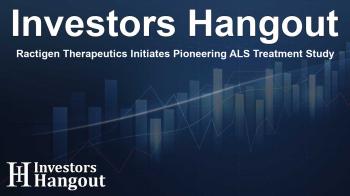Ractigen Therapeutics Initiates Pioneering ALS Treatment Study

Ractigen Therapeutics Initiates Pioneering ALS Treatment Study
Ractigen Therapeutics, an innovative clinical-stage pharmaceutical company focused on RNA-based therapies, has reached a significant milestone. The company successfully dosed its first patient in a Phase I clinical trial for RAG-17, a novel siRNA therapy aimed at targeting Amyotrophic Lateral Sclerosis (ALS) associated with mutations in the superoxide dismutase 1 (SOD1) gene.
About the Phase I Clinical Trial
This Phase I clinical trial operates under a randomized, double-blind, placebo-controlled design. The objective is to assess various important factors such as safety and tolerability, pharmacokinetics, pharmacodynamics, and preliminary efficacy of RAG-17 in patients diagnosed with SOD-ALS. Esteemed medical professionals, Dr. Yilong Wang and Dr. Zhiying Wu, lead the trial, working in conjunction with Dr. Huifang Shang from West China Hospital. Their combined expertise is essential in ensuring the trial's success.
Significance of the Trial
Dr. Long-Cheng Li, Founder and CEO of Ractigen Therapeutics, expressed his excitement about this achievement, stating, "The first patient dosed in the RAG-17 trial marks a pivotal milestone in our mission to combat ALS, one of the most devastating neurodegenerative diseases.” This reflects the company’s dedication to pioneering RNA-based therapies, which hold transformative potential for families grappling with the challenges posed by rare and severe illnesses like ALS.
Regulatory Approvals and Progress
RAG-17 has garnered Orphan Drug Designation from the U.S. Food and Drug Administration (FDA), an indication of its promise for treating a rare condition. Additionally, the FDA has authorized its Investigational New Drug (IND) application. The Center for Drug Evaluation (CDE) of China’s National Medical Products Administration also approved the IND in the following months. Notably, recent studies, including an Investigator-Initiated Trial (IIT), have provided promising data supporting RAG-17's therapeutic potential, captivating interest within the global scientific community, especially during recent neurology conferences.
Understanding RAG-17
RAG-17 operates through a specific mechanism to suppress the SOD1 gene in ALS patients presenting harmful mutations. Utilizing Ractigen's proprietary SCAD™ delivery platform, this siRNA conjugation aims to enhance delivery to the central nervous system, a crucial aspect for effective treatment. Preclinical studies in a hSOD1G93A mouse model exemplified significant therapeutic efficacy, including improved motor functions and increased survival rates. The IIT results indicated that RAG-17, when administered intrathecally, was well tolerated across various dose levels, showing only mild side effects and confirming its safety and efficacy profile.
About Amyotrophic Lateral Sclerosis (ALS)
ALS is a devastating neurodegenerative condition that significantly hampers life expectancy, often leading to respiratory failures within three to five years after diagnosis. Patients experience a spectrum of symptoms, ranging from muscle cramps and weakness to more severe manifestations like paralysis and the need for assisted breathing. Key to understanding this condition is recognizing that mutations in the SOD1 gene are responsible for around 20% of familial cases and 5% of sporadic cases.
The Vision of Ractigen Therapeutics
Positioned as a leader in small activating RNA (saRNA) development, Ractigen Therapeutics leverages advanced RNA activation mechanisms to enhance gene expression. This groundbreaking approach allows saRNA to target specific genes, facilitating the restoration of normal protein functions. Ractigen's innovative technologies are crucial in addressing diseases neglected by traditional methods, particularly those resulting from genetic downregulation or epigenetic silencing.
Frequently Asked Questions
What is RAG-17 and how does it work?
RAG-17 is an innovative siRNA therapy developed to suppress mutations in the SOD1 gene, which is linked to ALS. It uses Ractigen's SCAD™ platform to enhance delivery into the central nervous system.
Who is conducting the RAG-17 clinical trial?
The trial is led by Dr. Yilong Wang and Dr. Zhiying Wu, with collaboration from other esteemed medical professionals.
What stage is the RAG-17 trial currently in?
RAG-17 is currently in Phase I clinical trials, evaluating its safety and preliminary efficacy in patients with SOD-ALS.
What are the initial findings from the RAG-17 trial?
Early results from the Investigator-Initiated Trial show that RAG-17 is well tolerated, with minimal adverse effects and promising therapeutic efficacy.
How does Ractigen Therapeutics contribute to ALS research?
Ractigen is at the forefront of developing RNA-based therapies, striving to enhance gene expression to treat conditions like ALS effectively.
About Investors Hangout
Investors Hangout is a leading online stock forum for financial discussion and learning, offering a wide range of free tools and resources. It draws in traders of all levels, who exchange market knowledge, investigate trading tactics, and keep an eye on industry developments in real time. Featuring financial articles, stock message boards, quotes, charts, company profiles, and live news updates. Through cooperative learning and a wealth of informational resources, it helps users from novices creating their first portfolios to experts honing their techniques. Join Investors Hangout today: https://investorshangout.com/
Disclaimer: The content of this article is solely for general informational purposes only; it does not represent legal, financial, or investment advice. Investors Hangout does not offer financial advice; the author is not a licensed financial advisor. Consult a qualified advisor before making any financial or investment decisions based on this article. The author's interpretation of publicly available data shapes the opinions presented here; as a result, they should not be taken as advice to purchase, sell, or hold any securities mentioned or any other investments. The author does not guarantee the accuracy, completeness, or timeliness of any material, providing it "as is." Information and market conditions may change; past performance is not indicative of future outcomes. If any of the material offered here is inaccurate, please contact us for corrections.
